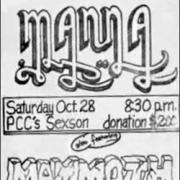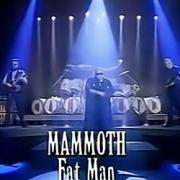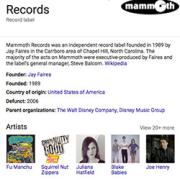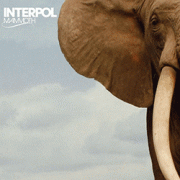It should come come as no surprise that the hairy, less-domesticated ancestor of the elephant would fascinate rock bands, heavy metal in particular. Over the years, there have been a number of bands named some variation on “Mammoth” or “Woolly Mammoth,” and many songs referencing the beast.
Image

Image

Image

Image

Image

Mammoth or mammoth-like creatures show up in fantasy and adventure stories, often as means of transport and mayhem (such as Tolkien’s six-tusked Mûmakil) or as the prey of hunters, as in Harry Turtledove’s Beyond the Gap and The Breath of God.
- Adventure fantasist Edgar Rice Burroughs’ 1937 novel Back to the Stone Age, his fifth set in the prehistoric inner-Earth of Pellucidar, featured the Mammoth Men, a tribe of cave-dwelling, woolly mammoth-riding natives. The hero escapes the captivity of these men during a gladiator-style contest pitting mammoths against sabertooth tigers.
- The Mammoth Hunters (1985) is the third in Jean M. Auel’s series of prehistorical novels begun with 1980’s Clan of the Cave Bear. It continues the story of Ayla and Jondalar, who make their home with the Mamutoi, or Mammoth Hunters, whose shaman introduces Ayla into the ranks of the clan’s mystics.
- Science fiction author Stephen Baxter wrote a trilogy, Silverhair, Longtusk (both 1999), and Icebones (2001), told from the perspective of woolly mammoths struggling to survive the emergence of men and a changing landscape. The third novel takes place in 3000 A.D., telling the story of mammoths brought back from extinction and now living on Mars.
- The DC Comics universe includes supervillain Mammoth, a founding member of the Fearsome Five, and enemy of the Teen Titans, Superman and the Outsiders. He boasts immense size and strength, but isn’t very bright or skilled at combat. He doesn’t actually resemble a mammoth.
- Manfred "Manny" is a woolly mammoth who has appeared in all five Ice Age films. Don’t call him fat: he’s furry.
- In 2006, the Sci Fi Channel presented Mammoth, featuring Tom Skerritt and nominated for an Emmy Award for Outstanding Special Visual Effects. Borrowing elements from the X-Files, Men in Black, Jurassic Park and various B-movie creature features, Mammoth tells the story of a town terrorized when a crashing meteor revives a 40,000-year-old frozen mammoth.
- Mommy for Little Mammoth (Мама для мамонтёнка) is a Soviet-made animated short from 1981 about a baby mammoth who wakes up from the Ice Age to find his mother gone, and goes in search of her.
- Mammoth (Swedish, 2009): No mammoths to be seen, although the protagonist does receive a mammoth ivory pen.
- Perhaps the most famous woolly mammoth known to television viewers is Mr. Snuffleupagus, the close friend of Sesame Street’s Big Bird. For 14 years, Snuffy was portrayed as an imaginary-not-imaginary friend who only Big Bird could see. Snuffy became visible to the rest of the characters in 1985, and he has remained a beloved character ever since. Watch him do the “Snuffle Shuffle.”
- The folks behind Sesame Street, the Children’s Television Workshop, also produced Cro (1993-94), a prehistoric-themed cartoon geared at teaching basic concepts of physics, mechanical engineering and technology. The cartoon revolved around the reminiscences of Phil, a talking woolly mammoth thawed from Arctic ice, involving his Cro-Magnon friend Cro, who lived with a family of Neanderthals.
- Fantasy artist Frank Frazetta devoted a 1974 painting to the mammoth, which has been used for different media, including the cover of “Back to the Stone Age.”
- If you have ever wanted to drink a mammoth, there’s a cocktail called the Woolly Mammoth, which consists of equal portions tequila, peach schnapps, coconut rum, plain rum and lime cordial, topped off with lemonade. There’s also the Black Mammoth, made with equal portions Canadian whisky, Scotch whisky, tequila and cognac.
- Between 1971 and 1975, the Aurora Model Co. produced a line of 17 model kits devoted to sometimes not-quite-so-scientifically-accurate “prehistoric scenes,” premiering a woolly mammoth kit in 1972. The John N. Hansen Toy Co. currently manufactures a “4-D” anatomic model, a cutaway revealing skeleton and organs.
- “Crazy Mammoths” is a free web-based computer game in which players race ice-encased mammoths down a snowy slope, evading penguins and trees, and jumping over each other. For a more graphically sophisticated gaming interaction with mammoths, there’s Far Cry Primal, in which the player hunts (or rides) woolly mammoths, fending off saber-tooth tigers.
- In Dungeons & Dragons, the Mammoth is classified as a “huge beast, unaligned,” with Class 13 natural armor. They represent the pinnacle of strength at 24 points, but are extremely vulnerable when it comes to dexterity (9), intelligence (3) or charisma (6). They can gore or stomp.